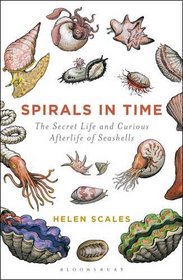I'm struggling to explain to myself why I didn't enjoy this as much as I thought I would. Seashells! What's not to love?
First off, I think I should make it clear that it was neither difficulty nor dryness: some low-star reviews complain that it's "booooring" and "reads like a textbook." (Oh, horrors ...) I am always up for some reading outside my comfort zone, and I understand that I'm going to have to put in some effort. And I accept that I might not absorb and retain every single word -- if I emerge from the experience with an insight into something new, I am happy.
So, not difficult or dry: in fact, if there was one thing that grated, it was Scales' efforts to be accessible and "relatable." Dumbed down, "cutesy" word choices, pop culture references that seems forced and arbitrary. Personal anecdotes that were making a point ... how?
And that leads me to the other problem I had: with the book's organization. Scales did her thesis no favours by bouncing around, from the deepest fossil record, to historical researchers of molluscs and shells, to uses that shells have been put to over the millennia (low-brow, high art, culture and spirituality, and everything in-between), to modern science and ecology, and the place that shell studies have in research on climate change. I didn't feel that she gave her arguments, and her evidence, a chance.
Having said that -- I came away with two fantastic images. First, the hermit crab "vacancy chain," where " a gaggle of hermit crabs clustered around a bit empty shell will sort themselves into a size-ordered line" and eventually, after some jockeying for position, all move up one size shell. There's a great metaphor there, and Scales is at her best in those pages, clear and genuinely funny.
The other was this marvellous little take-away, about the mollusc nervous system -- "... densely tangled nerves known as ganglia ... come as close as you will ever get to a general mollusc brain (the ganglia fuse to form a ring though which the oesophagus passes, which means that when a snail swallows, its food goes right though its mind."
I have days when I feel like that. So, worth reading, but could have been better, and more memorable.
First off, I think I should make it clear that it was neither difficulty nor dryness: some low-star reviews complain that it's "booooring" and "reads like a textbook." (Oh, horrors ...) I am always up for some reading outside my comfort zone, and I understand that I'm going to have to put in some effort. And I accept that I might not absorb and retain every single word -- if I emerge from the experience with an insight into something new, I am happy.
So, not difficult or dry: in fact, if there was one thing that grated, it was Scales' efforts to be accessible and "relatable." Dumbed down, "cutesy" word choices, pop culture references that seems forced and arbitrary. Personal anecdotes that were making a point ... how?
And that leads me to the other problem I had: with the book's organization. Scales did her thesis no favours by bouncing around, from the deepest fossil record, to historical researchers of molluscs and shells, to uses that shells have been put to over the millennia (low-brow, high art, culture and spirituality, and everything in-between), to modern science and ecology, and the place that shell studies have in research on climate change. I didn't feel that she gave her arguments, and her evidence, a chance.
Having said that -- I came away with two fantastic images. First, the hermit crab "vacancy chain," where " a gaggle of hermit crabs clustered around a bit empty shell will sort themselves into a size-ordered line" and eventually, after some jockeying for position, all move up one size shell. There's a great metaphor there, and Scales is at her best in those pages, clear and genuinely funny.
The other was this marvellous little take-away, about the mollusc nervous system -- "... densely tangled nerves known as ganglia ... come as close as you will ever get to a general mollusc brain (the ganglia fuse to form a ring though which the oesophagus passes, which means that when a snail swallows, its food goes right though its mind."
I have days when I feel like that. So, worth reading, but could have been better, and more memorable.




![header=[] body=[Get a free book credit right now by joining the club and listing 5 books you have and are willing to share with other members!] Help icon](/images/question.gif?v=90afaeb39)
